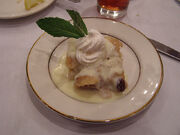
The bread pudding at Dooky Chase
Although bread pudding is a dish found in many cultures as a tasty way of using leftover bread, many feel it to be the most representative dessert of New Orleans. How did a dessert found in many cuisines become such a New Orleans icon? The answer lies both in the qualities of the bread and the Creole people who made it their own.
Unlike traditional French baguettes and other breads baked in communities with a ready supply of wheat, New Orleans French bread has a very airy texture. When combined with the custard base of many bread pudding recipes and served warm, the result is not heavy, as it would be when made with breads of a denser texture. Instead it manages to retain a light, pudding quality that turns what is normally a “homey” dessert into something fancy. As food writer Lafcadio Hearn notes in La Cuisine Creole (1885), “The Creole housewife often makes delicious morceaux from things usually thrown away by the extravagant servant.” From that time on, it has had a regular place on the table in the homes of New Orleans.
Its transition to a regular presence on restaurant menus was marked with changes that allowed the dessert to rise above its humble origins. Commander’s Palace offers a bread pudding soufflé; in the summer, when peaches are ripe, Clancy’s restaurant serves peach bread pudding; Culinary Teacher Lee Barnes served hers with an Amaretto Sauce, and The Palace Café offers a White Chocolate Bread Pudding. These alterations are beyond simply making a whiskey sauce or lemon sauce, as is suggested in The Picayune Creole Cookbook (1901). A housewife might be able to make a simple sauce like these while preparing the rest of a meal for her family. Instead, the dessert, now requiring extra time or more expensive ingredients, is elevated to something elegant, at odds with its frugal origins. As food historian Susan Tucker notes, “This association of bread pudding with New Orleans may be best understood by looking to the retention of French culinary traditions—thrifty in the home and grand in the public spaces.”